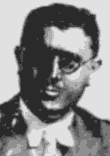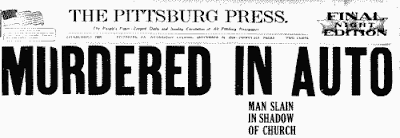Died Las Vegas, NV, Jan. 16, 1986.
Lewis McWillie's name will be forever linked with Dallas nighclub owner Jack Ruby. McWillie was a casino gambling operator who worked for notorious crime bosses and was idolized by Ruby. A 1958 Jack Ruby visit to McWillie in Havana, Cuba, and Ruby's 1963 murder of accused Kennedy assassin Lee Harvey Oswald connected McWillie to various Kennedy Assassination conspiracy theories.
McWillie was born in Missouri and grew up in Memphis, Tennessee, where he first became involved in gambling in the early 1930s. About 1936, he moved to Jackson and Osyka, Mississippi, and then, in 1940, to Dallas. He was known to be employed as a dealer in the Blue Bonnet Hotel in the early 1940s. He then became involved in casino-style gambling at the Top of the Hill Terrace in Arlington, Texas, and the Four Duces in Fort Worth. His administration of gambling enterprises brought him in contact with Dallas crime boss Joseph Civello. McWillie was seldom in trouble with the law. He was arrested in connection with a Dallas gambling investigation in 1949 but was quickly released.
Jack Ruby and Lewis McWillie met in the late 1940s. Local officials were forcing Ruby's night club to close early, and he needed a "connection" to set things right. McWillie put Ruby in touch with Julius Schepps, and the problem was resolved. McWillie later recalled, "From then on, I could never get rid of Jack Ruby."
In 1958, as American mobsters began injecting enormous amounts of cash into casino gambling in Havana, Cuba, McWillie relocated to the island nation. In Cuba, he worked at casinos backed by Tampa crime boss Santo Trafficante, underworld financier Meyer Lansky, Meyer's brother Jake Lansky, Norman Rothman, Sam and David Yaras and Dino Cellini.
McWillie first served as manager of the Lansky and Rothman-controlled Tropicana nightclub casino. He held that position until May 1960. He then became pit boss at the Salon Rojo casino of the Capri hotel controlled by Trafficante. While in the casino positions, he was an employee of Cuban brothers Martin and Pedro Fox and made frequent trips to the U.S., often making Florida bank deposits for the Foxes.
A number of McWillie trips from Cuba to the U.S. are documented in immigration records. Providing Dallas home addresses on Raleigh Street, Maple Terrace and Homer Street, he entered the U.S. from Cuba in October 1958; April, July and August, 1959; January, February, March, August, September (twice), October and November, 1960; and January 1961.
Ruby went to visit McWillie in Havana in the summer of 1959 - McWillie sent him airline tickets and arranged hotel accommodations, reportedly hoping that Ruby would bring Dallas newspaper columnist Tony Zoppi with him. Zoppi did not make the trip. Records indicate that Ruby was in Cuba more than a month. McWillie, however, insisted that the visit was no longer than six days. "Jack Ruby was that kind of fellow that six days would be long enough to be around him," McWillie once stated. "I am sure he wasn't there a month."
Ruby's Cuba stay occurred as Fidel Castro built his government, following the successful revolution against Fulgencio Batista. Santo Trafficante had been arrested and was being held at the Triscornia detention camp. McWillie reportedly visited the camp twice that summer but did not recall if Ruby went with him. McWillie recalled going to the camp to see Giuseppe DiGiorgio but also noted the presence of Trafficante, Jake Lansky and Dino Cellini. Trafficante later insisted that he never met Ruby. During Ruby's time in Cuba, Trafficante was released, and that coincidence has led some to insist that Ruby arranged the release.
After returning to the U.S. in 1961, McWillie traveled by car from Miami to Lake Tahoe, Nevada, stopping in Dallas to stay overnight at Ruby's apartment. According to McWillie, that was the last in-person encounter between the two men.
McWillie worked briefly as a pit boss at the Cal-Neva Lodge in Nevada in 1961 and then served as casino supervisor at the Reno, Nevada, Riverside Hotel between October 1961 and late spring or early summer of 1962. In May 1962, he married at Carson City. He later relocated to Las Vegas and took a casino supervisor post with the Thunderbird Hotel on the Strip. He worked there until the summer of 1964.
In the spring of 1963, Jack Ruby reportedly purchased a .38-caliber Smith & Wesson Centennial revolver and had it shipped to McWillie in Nevada. McWillie did not accept delivery of the package. Believed to have left the U.S. after that, possibly working in a foreign gambling operation.
Six months later, McWillie became a person of interest for federal law enforcement agents following Ruby's murder of Oswald. The FBI interviewed him in late November 1963 and again in June 1964. The Warren Commission, investigating the Kennedy Assassination, did not call McWillie to testify.
After 1964, McWillie held positions at the Carousel Club, Binion's Horseshoe Club and the Holiday Inn Casino at Las Vegas.
In the late 1970s, McWillie was interviewed by the House Select Committee on Assassinations.
The HSCA learned that McWillie had indeed made his own trips to the Triscornia camp while Trafficante was confined there. At the time of his testimony, McWillie said he was not certain whether Ruby had accompanied him on the trips. “I don’t recall it, but he could have,” McWillie said. “I don’t know for sure.”
McWillie said he went to Triscornia primarily to visit with his friend Giuseppe DiGiorgio but also saw Dino Cellini, Jake Lansky and Trafficante: “I didn’t talk to Trafficante because I didn’t know him that well to speak to him.”
McWillie died in Las Vegas on Jan. 16, 1986. He was 77 years old. His Nevada death record made him appear four years younger, by moving his birthdate from May 4, 1908, to May 4, 1912.
See also:
Sources:
- Air Passenger List, Immigration and Naturalization Service, departed Havana, arrived Miami, Florida, Oct. 26, 1958.
- Air Passenger List, Immigration and Naturalization Service, Flight 358, departed Havana, arrived Miami, Florida, April 30, 1959.
- Air Passenger List, Immigration and Naturalization Service, departed Havana, arrived Miami, Florida, July 7, 1959.
- Air Passenger List, Immigration and Naturalization Service, Flight 358, departed Havana, arrived Miami, Florida, Aug. 24, 1959.
- Air Passenger List, Immigration and Naturalization Service, Flight CCA-800, departed Havana, arrived Miami, Florida, Jan. 12, 1960.
- Air Passenger List, Immigration and Naturalization Service, departed Havana, arrived Miami, Florida, Feb. 1, 1960.
- Air Passenger List, Immigration and Naturalization Service, Flight CCA-998, departed Havana, arrived New York City, March 16, 1960.
- Air Passenger List, Immigration and Naturalization Service, departed Havana, Flight CCA-800, arrived Miami, Florida, Aug. 10, 1960.
- Air Passenger List, Immigration and Naturalization Service, Flight CCA-800, departed Havana, arrived Miami, Florida, Sept. 2, 1960.
- Air Passenger List, Immigration and Naturalization Service, Flight CCA-800, departed Havana, arrived Miami, Florida, Sept. 13, 1960.
- Air Passenger List, Immigration and Naturalization Service, Flight CCA-810, departed Havana, arrived Miami, Florida, Oct. 5, 1960.
- Air Passenger List, Immigration and Naturalization Service, Flight PA-412, departed Havana, arrived Miami, Florida, Nov. 7, 1960.
- Air Passenger List, Immigration and Naturalization Service, Flight CCA-804, departed Havana, arrived Miami, Florida, Jan. 2, 1961.
- Carson City, Nevada, Marriage Index.
- House Select Committee on Assassinations (HSCA Hearings), Appendix to Hearings Before the Select Committee of the U.S. House of Representatives, Volume IX, Staff and Consultant's Reports, U.S. House of Representatives, Ninety-Fifth Congress, Second Session, Washington, D.C.: U.S. Government Printing Office, 1979. Report may be accessed online through the History Matters website (https://history-matters.com/archive/jfk/hsca/reportvols/vol9/contents.htm ).
- McAdams, John, "Testimony of Lewis McWillie," Kennedy Assassination Home Page, http://mcadams.posc.mu.edu/russ/jfkinfo2/jfk5/mcwill.htm .
- McAdams, John, "Testimony of Santos Trafficante," Kennedy Assassination Home Page, http://mcadams.posc.mu.edu/russ/jfkinfo2/jfk5/traff.htm .
- Nevada Death Index.
- Social Security Death Index.
- United States Census of 1920, Tennessee, Shelby County, Ward 31, Enumeration District 219.
- "Lewis Joseph McWillie," Find A Grave, findagrave.com, March 31, 2010.
- "One-paragraph link to Nevada included in Warren report," Nevada State Journal, Oct. 9, 1964, p. 2.







